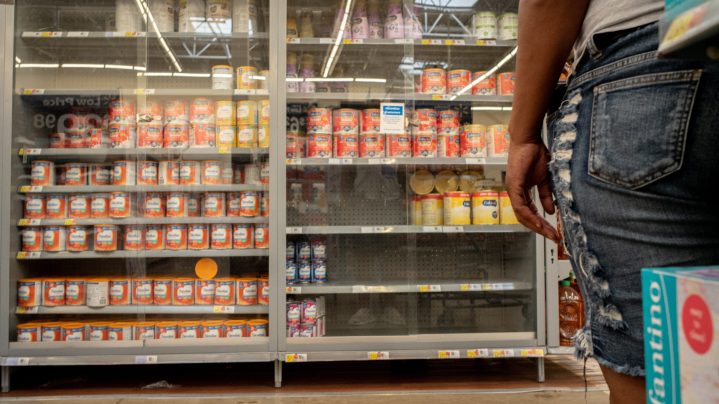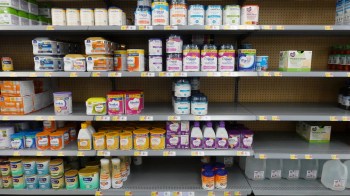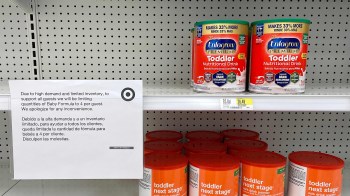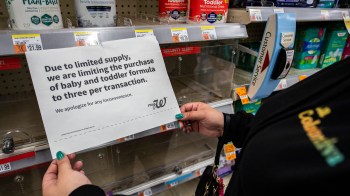
Many low-income parents still struggle to find baby formula, even as production rebounds
Many low-income parents still struggle to find baby formula, even as production rebounds

In February, Abbott Nutrition shut down a big infant formula plant in Michigan and recalled its popular Similac powder and two specialized formulas due to bacterial contamination. The combination of the plant shutdown and existing supply chain issues created a national shortage. In May, 43% of formula products went out of stock nationwide, throwing parents into a crisis virtually overnight.
More than 80% of infants consume formula during the first year of their lives. Even as production picks back up, many parents are still struggling to find it on shelves. Low-income mothers are having the most challenging time because they rely on formula to feed their babies at higher rates. As much as 65% of all formula in the U.S. is purchased through WIC, an assistance program for low-income women and children.
“Marketplace” host Kimberly Adams spoke with Mariel Padilla, a reporter for The 19th, about how we got here and how low-income parents are dealing with the issue. The following is an edited transcript of their conversation.
Kimberly Adams: We heard about this baby formula shortage back in May, when it seemed to be kind of at its worst. How are things going now?
Mariel Padilla: So things are looking a lot better than they were looking in May. I mean, as of the end of November, we’re near the same levels of in-stock that we were pre-shortage. We [have] about 12.5% of formula and baby powder out of stock, which is about where we were in January. But that being said, there are still a lot of mothers and families reporting having a hard time finding what they need. And I talked to experts about this, and this is because the shortage is looking more hyperlocalized. So there are certain stores at certain times in certain areas that will just be out of stock still. So it’s still not all the way back.
Adams: So even though a lot of formula is still available, there are still some kinds that are really hard to get, especially for certain communities. Can you explain that?
Padilla: Communities that are in rural areas or lower-income families that rely on the [Women, Infants, and Children] program sometimes have a hard time finding specialty formulas. These are formulas that are made for people with specific allergies or sensitive digestion or specific nutritional needs. And when one store doesn’t have that, sometimes these families are required to drive 20-30 miles away to try another store. And if that store doesn’t have it, they just have to continue this search. So even though it looks like the stores are stocked, it’s still a shortage in practice for many families.
Adams: In your article, you mentioned that low-income families — specifically women of color — more often rely on formula to feed their children. So how has the shortage affected them in particular?
Padilla: So, more than 80% of infants consume formula at some point in the first year of their lives. And so I think that’s important to know first. But then low-income parents, particularly women of color, rely on formula to feed their babies at higher rates. Because of, you know, their job situations — less flexibility, less parental leave, less opportunity to breastfeed on the job, those types of things. So women of color continue to be most impacted by the shortage.
Adams: What needs to happen to sort of eliminate the remaining shortage?
Padilla: Well, in the short term, the government did a lot of things that most of the experts agreed were great short-term fixes. Things like importing formula from other countries, revisiting regulation guidelines to help other competitors enter, looking into the current system and reevaluating how many manufacturing companies there are domestically, things like that. But in the long term, I think it’s going to be all about expanding the playing field and making it easier for more competition to enter the industry.
Adams: What resources are available for parents who are still having trouble finding formula for their babies?
Padilla: So the WIC program — like I mentioned, there are local WIC clinics all over the country that provide support and resources, educational materials on what practices to avoid to keep infants safe. These types of local clinics are where I would encourage any mother struggling to go for help, and then they would have more localized resources and advice there.
There’s a lot happening in the world. Through it all, Marketplace is here for you.
You rely on Marketplace to break down the world’s events and tell you how it affects you in a fact-based, approachable way. We rely on your financial support to keep making that possible.
Your donation today powers the independent journalism that you rely on. For just $5/month, you can help sustain Marketplace so we can keep reporting on the things that matter to you.

















